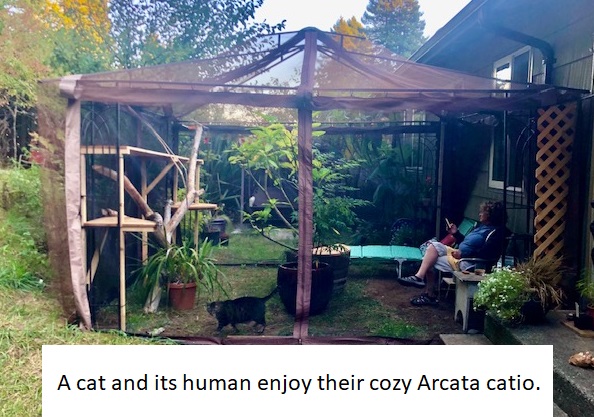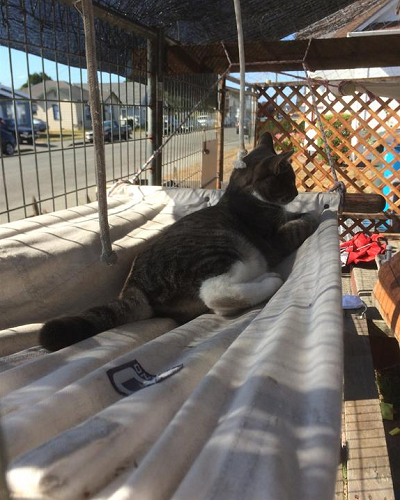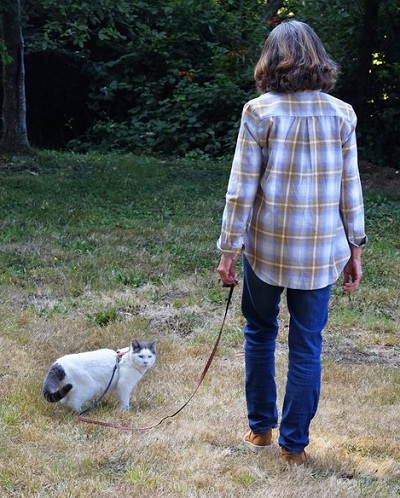
CATS INDOORS
Redwood Region Audubon Society advocates for the protection of birds and wildlife by supporting local conservation efforts to protect wildlife and their habitat.
RRAS is committed to educating the public on domestic cat control to protect cats and prevent cat predation on birds and other wildlife.

-
- We advocate for the humane and responsible ownership of cats.
-
- We recognize that the housecat is a domesticated species dependent on people to take care of it. Feral cats are more likely to suffer greatly and live much shorter lives than owned cats.
-
-
The domesticated cat evolved from the African cat species (Felis lybica lybica). It is an invasive species in the United States. Local native species did not evolve with domesticated cats and have little to no defense against being killed by them.
-
-
-
We support educational programs and materials that provide scientific information on the adverse effects of cats living outdoors and advocate for pet owners to keep cats indoors, in outdoor enclosures, or on a leash when outside.
-
It is estimated that 2.4 billion birds per year are killed by domestic cats in the U.S.
Why trap-neuter-release (TNR) doesn’t work.
TNR programs fail because they do not operate in a closed system and cannot spay or neuter a sufficient number of cats to affect feral cat numbers at the population level. Despite the good intentions of many involved in TNR programs, TNR has been found to be a waste of time, money, and resources.
Diseases
The three most common protozoal diseases in cats and humans are cryptosporidiosis, giardiasis, and toxoplasmosis.
-
-
Cryptosporidiosis, a highly contagious disease, can cause diarrhea, vomiting, fever, abdominal cramps, and dehydration in both cats and people.
-
Giardiasis is an often waterborne intestinal parasite that has oocysts (eggs) that are difficult to kill and filter.
-
Toxoplasmosis is a disease for which the cat is an obligate host in conjunction with rodents. Infected rodents become attracted to cat urine, which makes them easy prey. Cat feces can contain millions of toxoplasma. Although cats show no symptoms, the disease can infect humans, causing miscarriage and other effects not yet fully understood.
-
Outdoor cats suffer a much higher incidence of injury, parasites, and disease than cats kept indoors. Although some diseases — such as Feline Immunodeficiency Virus and Feline Leukemia Virus — are specific to cats, others can afflict a wide variety of species, including people.
In the U.S., cats are more likely than dogs to be rabid. There is no known, effective treatment for rabies once symptoms of the disease appear. There are effective vaccines that provide immunity to rabies only when administered soon after exposure. They may also be used for protection before exposure for people such as veterinarians and animal handlers. “TNR” programs do not effectively prevent or control rabies in feral cat populations as originally posited.
Outdoor cats can get into fights; be exposed to deadly viruses, hit by cars, and attacked by wild animals; and become poisoned.
We advocate for controlling cats in the same way in which we control dogs by advocating for changes to local animal ordinances.
- Cats are not very effective for rodent control - Click here to learn more.
- Cats are more of a threat to other wildlife and not effective for rat control - Click here to learn more.
What You Can Do
- Teach your cat to walk on a leash and take it on leashed walks as you would a dog.
- Identify your cat. Use a collar and tag or microchip your cat in case it gets lost.
- Don’t feed unknown cats without making a commitment to finding them a permanent home. Feeding stray cats will only establish their presence and lead to rapid growth in their numbers. Instead, take them to a local animal shelter where they have the chance to be adopted.
- Don’t allow food to be accessible to wildlife (except birds) or roaming cats.
- Spay or neuter your cat as early as eight weeks of age.
- Never abandon cats. This is illegal and cruel behavior. Instead, take the cat to an animal shelter where it has a chance of being adopted.
- Support laws that prevent cats from roaming.
- If you are unwilling to keep your cat indoors, do not attract birds to your yard by putting out bird feeders, birdhouses, or birdbaths.


Informative books
-
Cat Wars, The Devastating Consequences of a Cuddly Killer, by Peter Marra (View book at Amazon)
-
Among the Pigeons: Why Our Cats Belong Indoors, by John Read (View book at Amazon)
Helpful links
- American Bird Conservancy – Cats Indoors (Visit Link)
- Top Reasons to Keep Cats Indoors Visit Link
- Why Your Cat Should Stay Indoors – Part 1 Visit Link
- Why Your Cat Should Stay Indoors – Part 2 Visit Link
- New Mexico Audubon – Cats Indoors Visit Link
- House Cats Have Greater Impact on Local Wildlife than Wild Predators: Visit Link
- North Utah Valley Animal Services Special Service District conducted an analysis on "The Science of Feral Cats"
- Up-to-date information on Trap-Neuter-Reabandon effectiveness from the University of Florida Extension
https://edis.ifas.ufl.edu/uw468 - An entertaining primer on toxoplasma gondii, a disease of humans and other mammals which can only reproduce in cats.
https://www.youtube.com/watch?v=aA-POO8S01Y&t=2s - The best way to protect cats and birds is to keep cats safely contained. However, if you are in the process of transitioning your outdoor cat to an indoor cat or just want to add an extra layer of wildlife protection while your cat is in the backyard enclosure, several devices can help reduce (but not eliminate) cat predation.
https://abcbirds.org/catio-solutions-cats/
Catios and such –
-
- https://catiospaces.com/
-
https://habitathaven.com/collections/pre-designed-cat-enclosure-kits
-
https://www.pbs.org/american-
portrait/story/17547/jim-c- eureka-ca-when-i-step-outside- my-door -
This is fencing that can be installed to keep cats in a yard OR out of a yard: https://purrfectfence.com
Our Purpose
The purposes and objectives of this corporation shall be to engage in such educational, scientific, investigative, literary, historical, philanthropic, and charitable pursuits as may be part of the stated purposes of the National Audubon Society, of which this corporation shall function as a Chapter.

Contact Us
P. O. Box 1036
Eureka, CA 95502
Copyright © 2021 - Redwood Region Audubon Society